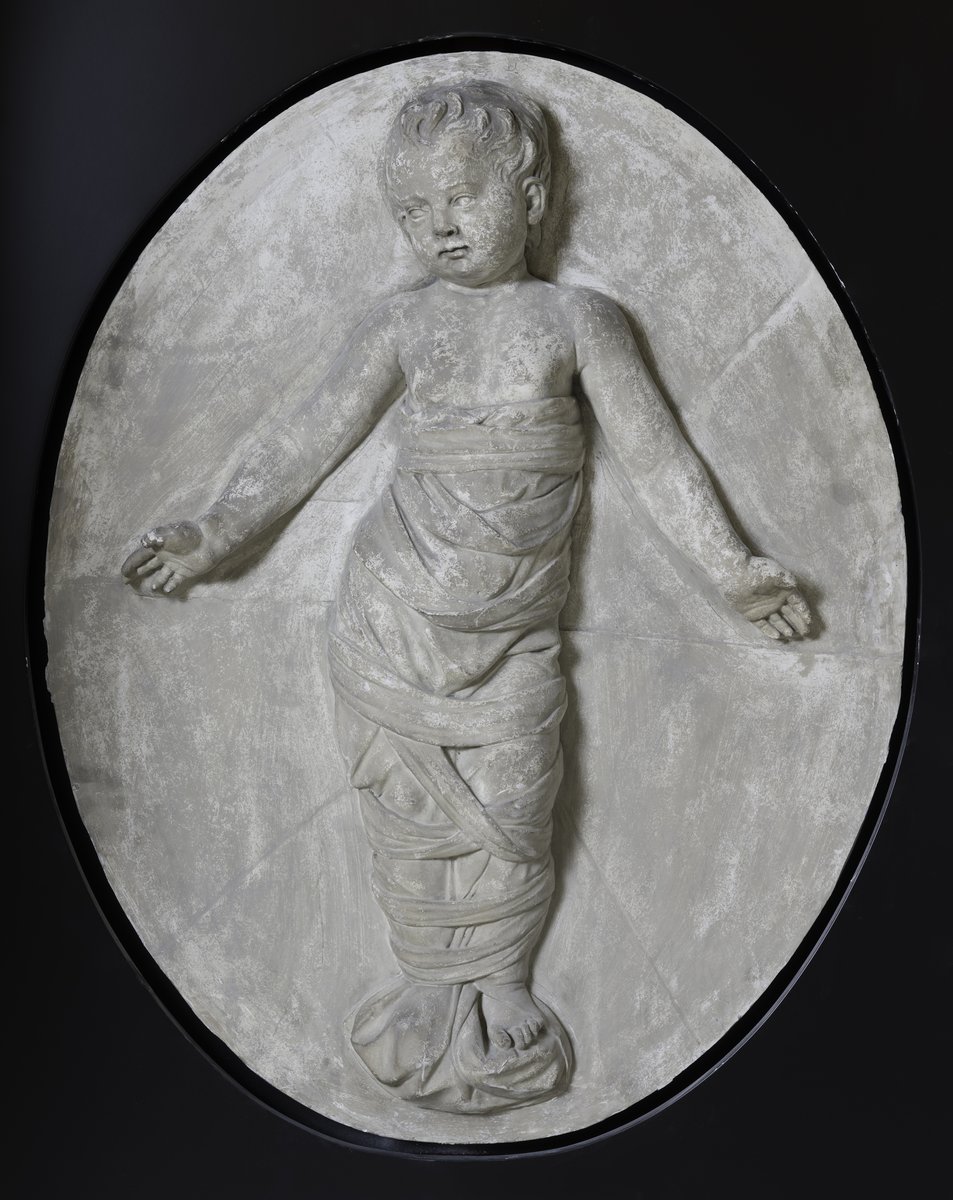
Roundel with Foundling Infant
Sculptures
| Artist | |
|---|---|
| Culture | Italian |
| Date | ca. 1470 |
| Object type | sculpture |
| Medium, technique | terracotta, with small residues of paint |
| Dimensions | 96 × 50 × 27 cm |
| Inventory number | 51.937 |
| Collection | Sculptures |
| On view | Museum of Fine Arts, First Floor, European Art 1250-1600, Gallery XIII |
Portrayed in three-quarter view, Christ seems to be rising out of a coffin. In view of its emphasis on the wounds, the Vir Dolorum, or Man of Sorrows, refers to Christ’s death on the cross, the victory over death, and the redemption of mankind. The terracotta statue was originally painted: on the red terracotta ground, the loin-cloth was painted blue, the flesh whitish grey, and the hair and the eyes were brown. Being composed for the main view and with a reverse side hollowed out, the statue once stood in a semi-circular niche. The type of the head and the anatomy of the hand and the body show clear affinities with Verrocchio’s early works. The Florentine master was an outstanding quattrocento painter, sculptor, and goldsmith, an innovative and experimenting artist, who studied in the workshop of Leonardo da Vinci. This exquisite work was once part of Ferenc Pulszky’s collection and was accompanied by two kneeling angels (currently held by the Toledo Museum of Art, United States); it was later shown that the three pieces did not originally belong together.
Balogh, Jolán, Katalog der ausländischen Bildwerke des Museums der bildenden Künste in Budapest, IV – XVIII. Jahrhundert: 1. Textband Bd. 1, Akadémiai Kiadó, Budapest, 1975, p. 70., no. 66.
Pope-Henessy, John, “Italian sculpture – Budapest and Paris”, Apollo 102.161-166 (1975), p. 474-475.
Dal Poggetto, Maria Grazia Ciardi Dupré, “Recensione – Jolán Balogh, Katalog der ausländischen Bildwerke der Museums der bildenden Künste in Budapest. IV-XVIII Jahrhundert Budapest, Akadémiai Kiadó, 1975 Vols. 2: I, Textband; II, Bildband.”, Prospettiva 8-11 (1977), p. 63-67.
Szmodisné Eszláry, Éva, A Régi Szoborgyűjtemény kincsei, Szépművészeti Múzeum, Budapest, 1994, p. 20, ill. 11.
Szmodisné Eszláry, Éva, The treasures of the Old Sculpture collection, Szépművészeti Múzeum, Budapest, 1994, p. 20.
Verrocchio Krisztusa/Verrocchio’s Christ, Szépművészeti Múzeum, Budapest, 2003.
Szépművészeti Múzeum: Remekművek az ókortól napjainkig. 100 év, Szépművészeti Múzeum, Budapest, 2006, no. 39.
Museum of Fine Arts, Budapest: Masterpieces from the Collection, Museum of Fine Arts, Budapest, 2006, no. 39.
The Museum of Fine Arts Budapest: guide, Museum of Fine Arts, Budapest, 2006, p. 138-139, no. 182.
Museum of Fine Arts: highlights from the collection, Szépművészeti Múzeum, Budapest, 2019, p. 104-105.
Szépművészeti Múzeum: Remekművek az ókortól a 18. század végéig, Szépművészeti Múzeum, Budapest, 2019, p. 104-105.
Museum of Fine Arts: Highlights from the Collection, Museum of Fine Arts, Budapest, 2019, p. 104-105.
Múzeumi kalauz: Vezető a Szépművészeti Múzeum régi gyűjteményeihez, Szépművészeti Múzeum, Budapest, 2021, p. 90.
Museum Guide: Old collections of the Museum of Fine Arts, Budapest, Museum of Fine Arts, Budapest, 2021, p. 90.
This record is subject to revision due to ongoing research.